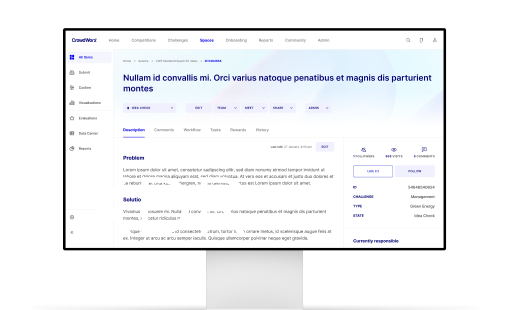Environmental scanning is the systematic process of collecting and analyzing information about external influences. And it plays a vital role in identifying trends through a comprehensive environmental scan. If you’re an Innovation Director or Manager in a large corporation, mastering environmental scanning can unlock strategic insights for you and drive innovation and growth within your company.
This article will guide you through effective environmental scanning techniques, addressing the challenges faced by innovation leaders and offering actionable insights to enhance your innovation strategies.
What is environmental scanning?
Environmental scanning is the process of gathering, analyzing, and interpreting relevant data about the internal and external environment of an organization to predict future events and identify opportunities and threats. It’s a critical component of strategic planning, helping businesses understand how their markets are changing and evolving. Without proper environmental scanning it will be difficult to stay ahead of the next disruption and or to drive growth through a continuous process of gathering and analyzing data.
Benefits of environmental scanning as a continuous process
There’s a reason why environmental scanning is a critical tool for Chief Innovation Officers (CINOs) and Innovation Directors. It’s because it provides the necessary context and insights to drive effective innovation strategies, identify opportunities, mitigate risks, and keep the organization ahead of market trends and competitive forces. Environmental scanning relies on the ability to provide quality data, which is essential for making informed decisions and driving effective innovation strategies.
Its main benefits include:
- Discovering new opportunities: Identify new opportunities for innovation and validate them quickly.
- Staying ahead of trends: Anticipate future challenges and opportunities to adapt to changing market conditions.
- Competitive intelligence: Gain insights into competitors’ activities, strategies, and innovations to position your organization effectively.
- Informing innovation strategy: Shape the organization’s innovation focus and strategy in alignment with external trends and market demands.
- Identifying emerging technologies: Stay informed about new tech and innovations that could disrupt your industry or create new opportunities.
- Customer insights: Reveal changing customer preferences, needs, and behaviors essential for driving customer-centric innovation.
- Risk management: Monitor external factors to identify potential threats and develop mitigation strategies.
- Ecosystem connections: Connect with the broader ecosystem in an open innovation context, fostering partnerships and collaborations.
- Continuous learning: Promote a culture of continuous learning and adaptation within the innovation team and the broader organization.
- Strategic decision-making: Enable more informed decisions about innovation investments, resource allocation, and strategic priorities.
The 4 elements of environmental scanning
Staying alert and keeping watch are key concepts that will help companies stay ahead of marketplace changes. Here are four areas to watch to remain an alert business leader:
1. Look for emerging trends in behavior and thinking:
- Train teams to look for shifts: As a leader, you should train your team to pay attention to shifts around them, including changes in internal components such as human resources and technological resources. Aware teams can alert leadership to new trends.
- Monitor changes in business perception: Track changes in how your product or business is viewed. You should also review important cultural or community shifts.
- Understand market sentiment early: Leaders who lead in the future understand market sentiments before they become mainstream. Seek to understand customer emotions and get insights into current and potential customers’ desires.
2. Look for new starts in the marketplace:
- New entrants into the market: Monitor new market entries, new products, and technological advancements.
- New customer attitudes and desires: Stay attuned to shifts in customer attitudes and needs.
3. Scan for offering substitutes:
- Identify potential substitutes: As a leader, you need to know how consumers might substitute another product for yours, and what changes you should make to stay ahead of the competition.
- Build unique products: Your business or product shouldn’t be easy to duplicate if you want to maintain a lasting competitive advantage.
4. Scan for signs of what’s ahead:
- Changing customer expectations: Train teams to notice signs of changing customer expectations through complaints and suggestions.
- Stock market indicators: The stock market may indicate potential signs of economic health and industry trends.
- Workforce changes: Review signs of change in the generational workforce in terms of their expectations and behavior.
Techniques for effective environmental scanning and market research
Here are some key techniques for effective environmental scanning to identify market trends:
a. PESTEL analysis
A PESTEL analysis is a framework used by innovation managers to analyze macro-environmental factors that affect an organization. The abbreviation in its name stands for political, economic, social, technological, environmental, and legal factors. Political: Government policies, regulations, and political stability.
- Economic: Economic growth, exchange rates, and inflation rates.
- Social: Cultural trends, demographics, and consumer behaviors.
- Technological: Technological advancements, innovation rates, and R&D activity.
- Environmental: Environmental regulations, climate change, and sustainability initiatives.
- Legal: Legislation, regulatory changes, and legal compliance.
By examining each of these areas, you can identify potential opportunities and threats.
b. SWOT analysis
A SWOT analysis involves assessing an organization’s internal strengths and weaknesses, as well as external opportunities and threats. This technique helps innovation managers understand their competitive position and identify areas for improvement.
- Strengths: Internal capabilities and resources.
- Weaknesses: Internal limitations and challenges.
- Opportunities: External factors that can be leveraged for growth.
- Threats: External factors that could hinder progress.
Engage key stakeholders in the SWOT analysis process to ensure that diverse perspectives are considered.
c. Competitive intelligence
Competitive intelligence involves gathering and analyzing information about your competitors’ activities, products, and strategies. Innovation managers can use this technique to understand the competitive landscape and identify market gaps. An environmental scanning committee can be instrumental in gathering and analyzing competitive intelligence, providing valuable insights for strategic decision-making.
- Tools and methods: Patent analysis, product benchmarking, and market share analysis.
d. Market research tools and methods
Market research is essential for understanding customer needs, preferences, and behaviors. Effective environmental scanning incorporates various market research tools and methods. To be effective, market research should also consider the surrounding environment, including changes in market conditions and consumer behavior.
- Surveys and questionnaires: Collect quantitative data from a large audience.
- Focus groups: Gather qualitative insights from a small, diverse group.
- Industry reports and white papers: Access comprehensive market analyses.
- Big data and analytics: Analyze large datasets to identify patterns and trends.
e. Social media monitoring
Social media platforms offer valuable insights into consumer sentiment, emerging trends, and competitor activities. Monitoring social media can help you stay ahead of market changes as an innovation manager.
- Tools for social media monitoring: Hootsuite, Brandwatch, and Sprout Social.
Conclusion
Environmental scanning enables businesses to stay ahead of disruption and drive growth, and as such, it’s a critical component of strategic planning. It provides a framework for analyzing internal and external factors, identifying opportunities and threats, and informing business decisions.
By understanding and implementing techniques such as PESTEL analysis, SWOT analysis, competitive intelligence, market research, and social media monitoring, Innovation Directors and Managers can stay ahead of market changes and enhance their innovation strategies.
This way, continuous environmental scanning fosters a proactive approach to innovation, making it easier for companies to adapt and thrive in a dynamic business environment. Start integrating these techniques into your innovation process today to unlock strategic insights and drive sustainable growth.

